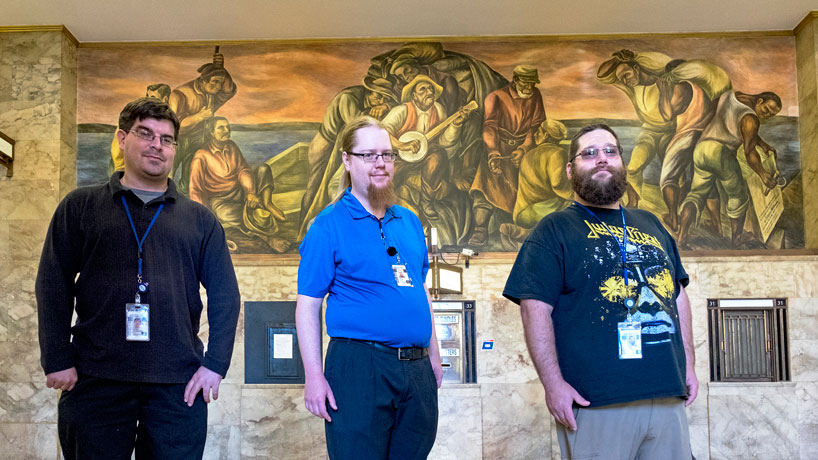
(From left) Edwin Schaeffer, David Ellis and James Vaughn stand in front of “The River,” one of the Edward Millman murals documenting St. Louis history at the USPS St. Louis Post Office, where they work downtown. The computer science alumni represent the past three promotions in the USPS St. Louis I/T Solutions Center, all stepping up to the title of computer programmer/analyst. (Photo by August Jennewein)
There’s a lot that goes into getting mail from point A to point B. There’s postmarking, sorting, transporting and delivering – all the typical processes customers of the United States Postal Service associate with the task. But no one really thinks information technology when they think mail – that is, no one except IT guys like David Ellis, Edwin Schaeffer and James Vaughn.
The three University of Missouri–St. Louis computer science alumni work at the USPS St. Louis I/T Solutions Center downtown. They help ensure mail gets to doorsteps seamlessly by supporting the government agency’s intranetwork and backend coding.
The St. Louis branch is one of four USPS solution centers in the country. Among numerous responsibilities, the St. Louis center processes all money orders purchased at post offices across the country, manages all 40,000 USPS buildings and the vehicle fleet of 200,000.
Working alongside 11 other UMSL alumni, Ellis, Schaeffer and Vaughn are the latest IT employees to receive promotions to computer programmer/analyst in the department of 325 employees.
“That’s probably because of the way the UMSL computer science program is structured,” says Vaughn, who graduated with his bachelor’s degree in December 2014. “They base their teaching on theory. It’s not just, ‘Here’s a Java book, learn how to write Java.’ It’s, ‘Here’s how a computer works.’ Since UMSL doesn’t focus on the specific languages or programming models, it made it easier to learn other languages and models because you understand the basics of how everything goes together.”
Schaeffer is quick to point out that promotions probably come easier with age and maturity, too. All three of the guys are in their 30s and came back to school after many years in private industry.
“We took a circuitous route,” says Ellis, who once managed a copy shop. “Maturity definitely helps. But it’s also that I had time to figure out exactly what I wanted to do, and it certainly wasn’t working in that copy shop anymore.”
Ellis graduated with his bachelor’s degree in December 2013, and Schaeffer followed in May 2014. All three had jobs at USPS within four months of graduation.
“I consider UMSL one of our better target schools,” says John Monda, the resource manager of the IT department, who notes that salaries start out at $67,100 right now. “It’s got a good curriculum for what we’re looking for, and the students that are coming from there tend to be more career-focused.”
Monda also stressed that he’s looking for strong coders, something that UMSL’s computer science program prides itself on producing.
“You can go on YouTube and learn how to program,” explains Vaughn. “But you’re probably not going to learn to program well. Things won’t scale because you’re not familiar with how performance works, and you’re probably not designing with any forethought for the future.”
Forethought is something stressed to computer science majors at UMSL.
“Problems such as improper or inefficient database entity relationships, which happen in early design phases, can wreak havoc if not discovered until later,” Schaeffer says. “My personal experience after seeing these phenomena firsthand is that people who are computer science majors are more likely to catch bugs faster and not make early design flaws.”
Schaeffer says he learned this from former adjunct instructor and UMSL alumnus Tomasz Mozolewski, who is now a senior software engineer at Riot Games in St. Louis. But the guys also mention UMSL professors Sanjiv Bhatia and Cezary Janikow as instrumental in their learning.
“They’re the leaders of the department – the two that teach the highest level of courses and some of the most difficult material,” Ellis says.
“You have enormous respect for them,” Schaeffer says. “They end up sorting out the people who are willing to rise to their challenges and go on to be professionals in the field.”
At the St. Louis I/T Solutions Center, Schaeffer is responsible for change management software, while Ellis works on the missing mail and mail recovery application.
“We ship a very large number of packages, and inevitably, there’s a few that get lost in the process,” he says.
The missing mail application makes it easier to keep track of the package inventory and submit and track searches for people who are looking for their lost mail. USPS rolled out the new missing mail site in June on USPS.com.
Vaughn works on the subversion repository for USPS, where all the source code for the agency is stored nationwide.
“It’s a lot better since he’s been here,” Ellis says. “Much faster.”
Vaughn updated the center from a single core server with Windows 2003 on it and only three gigs of memory to a server with 12 cores and 16 gigs of memory. He also works on the Advanced Deployment Management System that tests every programmers’ code before it goes live.
It’s all very self-driven work, something the three guys appreciate along with the laid-back culture.
“Other places for programming work are very classic business atmosphere, very ‘Join the man’ with business suits,” says Vaughn, who is wearing a Judas Priest T-shirt this day. “Ironically, we work for the government, and it’s not like that.”
“Priorities are in a better place here,” Ellis explains. “We’re focused on the coding, and it’s not regimented in a limiting way.”
Experienced Java software developers interested in working at the USPS St. Louis I/T Solutions Center should contact John Monda at john.w.monda@usps.gov or visit him at a future UMSL career fair.















